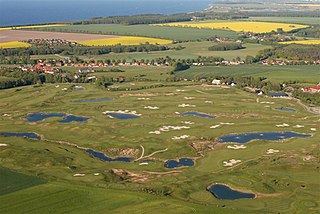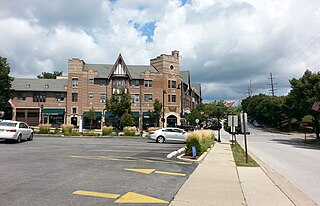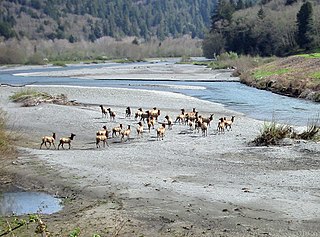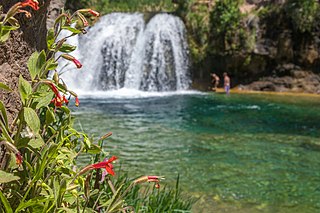This article possibly contains original research .(May 2009) (Learn how and when to remove this template message) |
| Butterfield Creek | |
|---|---|
| Physical characteristics | |
| Main source | Cook County near Matteson, Illinois 713 ft (217 m) 41°29′49″N87°45′12″W / 41.4969444°N 87.7533333°W |
| River mouth | Confluence with Thorn Creek, Glenwood, Illinois 610 ft (190 m) 41°32′46″N87°37′26″W / 41.5461111°N 87.6238889°W Coordinates: 41°32′46″N87°37′26″W / 41.5461111°N 87.6238889°W |
| Length | 15 mi (24 km) |
| Basin features | |
| Progression | Butterfield Creek → Thorn Creek → Little Calumet → Calumet → Lake Michigan → Great Lakes → Saint Lawrence Seaway → Gulf of Saint Lawrence |
| GNIS ID | 405303 |
Butterfield Creek is a 15.2-mile-long (24.5 km) [1] tributary of Thorn Creek near Chicago, Illinois, United States. [2] Via Thorn Creek, it is part of the Calumet River watershed flowing to Lake Michigan. It is at its widest around the towns of Homewood, Chicago Heights and Glenwood. The creek starts in a small marsh in Matteson and reaches its confluence with Thorn Creek in Glenwood.

A tributary or affluent is a stream or river that flows into a larger stream or main stem river or a lake. A tributary does not flow directly into a sea or ocean. Tributaries and the main stem river drain the surrounding drainage basin of its surface water and groundwater, leading the water out into an ocean.
Thorn Creek is a 20.8-mile-long (33.5 km) tributary of the Little Calumet River that travels through Will and Cook counties in northeastern Illinois just south of Chicago. It starts in the high land of the Valparaiso Moraine before dropping 200 feet (60 m) to the lower elevations of the Little Calumet River valley. Along its path it has cut many deep ravines and valleys. It is usually quite narrow, though the width of the river varies. Under 26th Street in Chicago Heights, a dam built in 1928 forms Sauk Lake, but just north of the street it is just a few feet across. This dam creates an accumulation of several feet of silt in Sauk Lake and is being considered for Notching in 2016 by the Corps of Engineers. The intent is to 'improve stream habitat'. The impact upon Ground Water Recharge, mitigation of Thorn Creek's 'flashiness' and future recreational activities are also concerns of Water-Shed Stakeholders.

Chicago, officially the City of Chicago, is the most populous city in Illinois and the third most populous city in the United States. With an estimated population of 2,716,450 (2017), it is the most populous city in the Midwestern United States. Chicago is the county seat of Cook County, the second most populous county in the United States, and the principal city of the Chicago metropolitan area, which is often referred to as "Chicagoland." The Chicago metropolitan area, at nearly 10 million people, is the third-largest in the United States; the fourth largest in North America ; and the third largest metropolitan area in the world by land area.
Butterfield Creek is severely degraded by a variety of pollutants including heavy metals, DDT, bacteria, and sediment which limits the stream's habitat potential. Several sewage treatment plants discharge into the stream. Riparian habitat is also severely disturbed by a combination of extreme discharges of stormwater and development. The stream has been the focus of many efforts to restore and protect water quality undertaken by a variety of governmental, non-governmental and private entities.

Dichlorodiphenyltrichloroethane, commonly known as DDT, is a colorless, tasteless, and almost odorless crystalline chemical compound, an organochlorine, originally developed as an insecticide, and ultimately becoming infamous for its environmental impacts. It was first synthesized in 1874 by the Austrian chemist Othmar Zeidler. DDT's insecticidal action was discovered by the Swiss chemist Paul Hermann Müller in 1939. DDT was used in the second half of World War II to control malaria and typhus among civilians and troops. Müller was awarded the Nobel Prize in Physiology or Medicine "for his discovery of the high efficiency of DDT as a contact poison against several arthropods" in 1948.
Butterfield Creek flows through several country club golf courses in Olympia Fields, Flossmoor, and Homewood; management of these tracts has degraded in-stream and riparian conditions necessary for wildlife movement.

A golf course is the grounds where the game of golf is played. It comprises a series of holes, each consisting of a teeing ground, a fairway, the rough and other hazards, and a green with a flagstick ("pin") and hole ("cup"). A standard round of golf consists of 18 holes. Most courses contain 18 holes; some share fairways or greens, and a subset has nine holes, played twice per round. Par-3 courses consist of nine or 18 holes all of which have a par of three strokes.

Olympia Fields is a village in Cook County, Illinois, United States. The population was 4,988 at the 2010 census. The municipality grew up around the prestigious Olympia Fields Country Club, originally established in 1915.

Flossmoor is a village in Cook County, Illinois, United States. The population was 9,464 at the 2010 census.
The Butterfield Creek corridor continues to provide some habitat connectivity between upland headwaters and the complex of Cook County Forest Preserve District properties along Thorn Creek. The Town of Homewood has created a run/walk trail along portions of lower Butterfield Creek.













